
Olympus Mons is a large shield volcano on Mars. The volcano has a height of over 21.9 km as measured by the Mars Orbiter Laser Altimeter (MOLA). Olympus Mons is about two and a half times Mount Everest's height above sea level. It is one of the largest volcanoes, the tallest planetary mountain, and approximately tied with Rheasilvia as the tallest mountain currently discovered in the Solar System. It is associated with the Tharsis Montes, a large volcanic region on Mars.

Ridge and furrow is an archaeological pattern of ridges and troughs created by a system of ploughing used in Europe during the Middle Ages, typical of the open-field system. It is also known as rigand furrow, mostly in the North East of England and in Scotland.

In neuroanatomy, a gyrus is a ridge on the cerebral cortex. It is generally surrounded by one or more sulci. Gyri and sulci create the folded appearance of the brain in humans and other mammals.
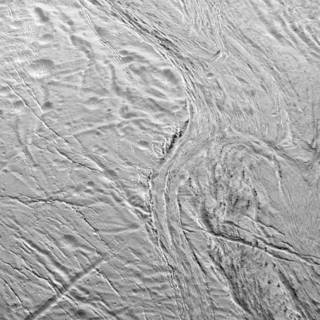
Samarkand Sulci is a region of grooved terrain on the surface of Saturn's moon Enceladus. The feature is centered at 30.5° North Latitude, 326.8° West Longitude and is approximately 383 kilometers long. Samarkand Sulci consists of three parts. The southern and eastern extensions bound Sarandib Planitia on its western and northern sides, respectively. The northern portions extends into a region of cratered terrain.

Mount Baker Wilderness is a 119,989-acre (48,558 ha) wilderness area within the Mount Baker-Snoqualmie National Forest in the western Cascade Range of northern Washington state. Its eastern border is shared with the boundary of the Stephen Mather Wilderness and North Cascades National Park for a distance of 40 miles. The wilderness extends from State Route 20 north to the Canada–US border. On the west, it is bounded by the foothills of the Puget Sound lowlands.

Amazonis Planitia is one of the smoothest plains on Mars. It is located between the Tharsis and Elysium volcanic provinces, to the west of Olympus Mons, in the Amazonis and Memnonia quadrangles, centered at 24.8°N 196.0°E. The plain's topography exhibits extremely smooth features at several different lengths of scale. A large part of the Medusae Fossae Formation lies in Amazonis Planitia.

The tiger stripes of Enceladus consist of four sub-parallel, linear depressions in the south polar region of the Saturnian moon. First observed on May 20, 2005 by the Cassini spacecraft's Imaging Science Sub-system (ISS) camera, the features are most notable in lower resolution images by their brightness contrast from the surrounding terrain. Higher resolution observations were obtained by Cassini's various instruments during a close flyby of Enceladus on July 14, 2005. These observations revealed the tiger stripes to be low ridges with a central fracture. Observations from the Composite Infrared Spectrometer (CIRS) instrument showed the tiger stripes to have elevated surface temperatures, indicative of present-day cryovolcanism on Enceladus centered on the tiger stripes.

In neuroanatomy, a sulcus is a depression or groove in the cerebral cortex. It surrounds a gyrus, creating the characteristic folded appearance of the brain in humans and other mammals. The larger sulci are usually called fissures.

The dwarf sawtail catshark is a little-known species of catshark, belonging to the family Scyliorhinidae, found exclusively in the deep waters off Luzon in the Philippines. Unlike other members of its genus, this slender, diminutive shark has a short, rounded snout and very short furrows at the corners of its jaws. It has indistinct darker saddles beneath each dorsal fin and two dark bands on the caudal fin, as well as a prominent crest of enlarged dermal denticles along the upper caudal fin margin.
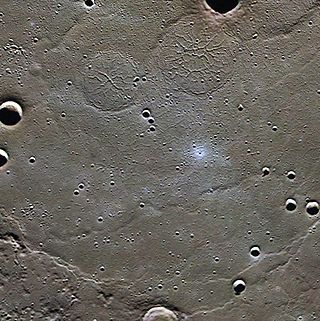
Goethe Basin is an impact basin at 81.4° N, 54.3° W on Mercury approximately 317 kilometers in diameter. It is named after German poet Johann Wolfgang von Goethe.

Meteoraspis is an extinct genus of ptychopariid trilobites of the family Tricrepicephalidae. The various species lived from 501 to 490 million years ago during the Dresbachian faunal stage of the late Cambrian Period. Fossils of Meteoraspis are characteristic of Late Cambrian strata in North America, though they are found in Late Cambrian strata elsewhere in the world, such as M. nevensis from Victoria Land, Antarctica.

The Diacria quadrangle is one of a series of 30 quadrangle maps of Mars used by the United States Geological Survey (USGS) Astrogeology Research Program. The quadrangle is located in the northwestern portion of Mars’ western hemisphere and covers 180° to 240° east longitude and 30° to 65° north latitude. The quadrangle uses a Lambert conformal conic projection at a nominal scale of 1:5,000,000 (1:5M). The Diacria quadrangle is also referred to as MC-2. The Diacria quadrangle covers parts of Arcadia Planitia and Amazonis Planitia.

The Amazonis quadrangle is one of a series of 30 quadrangle maps of Mars used by the United States Geological Survey (USGS) Astrogeology Research Program. The Amazonis quadrangle is also referred to as MC-8.

Sulci Gordii in the feature in the Tharsis quadrangle of Mars. Sulci is a term used for subparallel furrows and ridges. It is located at 18.9° north latitude and 125.5° west longitude. It is 400 km long and was named after a classical albedo feature name. The term "sulci" is applied to subparallel furrows and ridges.
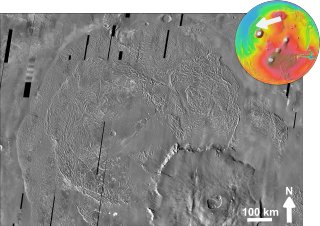
Lycus Sulci is a feature in the Amazonis quadrangle on Mars, with its location centered at 24.6° north latitude and 141.1° west longitude. It is 1,350 km long and is named after a classical albedo feature name. The term "sulci" is applied to subparallel furrows and ridges.
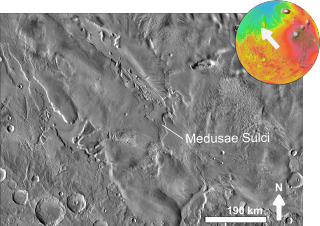
Sulcus is, in astrogeology, an area of complex parallel or subparallel ridges and furrows on a planet or moon.
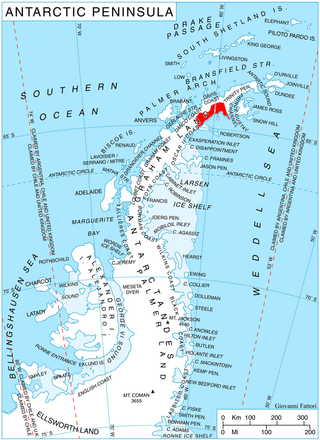
Enravota Glacier is the 10 km long and 3.5 km wide glacier on Nordenskjöld Coast in Graham Land situated southwest of Vrachesh Glacier and north of lower Drygalski Glacier. It drains the south slopes of Ruth Ridge, and flows southeastwards to join Drygalski Glacier east of Bekker Nunataks. The feature is named after the Bulgarian prince St. Boyan-Enravota.
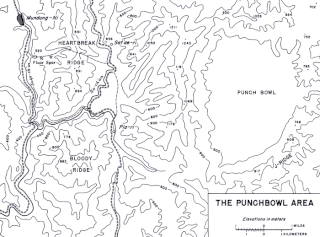
The Battle of the Punchbowl, was one of the last battles of the movement phase of the Korean War. Following the breakdown of armistice negotiations in August 1951, the United Nations Command (UN) decided to launch a limited offensive in the late summer/early autumn to shorten and straighten sections of their lines, acquire better defensive terrain, and deny the enemy key vantage points from which they could observe and target UN positions. The Battle of Bloody Ridge took place west of the Punchbowl from August–September 1951 and this was followed by the Battle of Heartbreak Ridge northwest of the Punchbowl from September–October 1951. At the end of the UN offensive in October 1951, UN forces controlled the line of hills north of the Punchbowl.

Sabazios Glacier is the 10 nautical miles long and 3 nautical miles wide glacier on the east side of northern Sentinel Range in Ellsworth Mountains, Antarctica. It is situated south of Newcomer Glacier, west of Anchialus Glacier, north of Embree Glacier, and east of Zhenda Glacier and Skaklya Glacier. The glacier drains the east slopes of Mount Alf and Mount Sharp, and the north slopes of the side ridge that trends 9.15 km from Mount Dalrymple on the main crest of Sentinel Range east-northeast to Robinson Pass, flows northwards and joins Newcomer Glacier northwest of Mount Lanning in Sostra Heights.

The 2018 Pacific typhoon season was formerly the costliest Pacific typhoon season on record before being surpassed the following year. The season had no official boundaries, and storms can form year-round, as evidenced by the formation of Tropical Storm Bolaven in late December 2017, and Tropical Storm Pabuk on December 31, 2018. Despite this, activity usually peaks between May and November. The season featured above-average activity, with 29 named storms, 13 typhoons, and 7 super typhoons forming in the West Pacific.




















